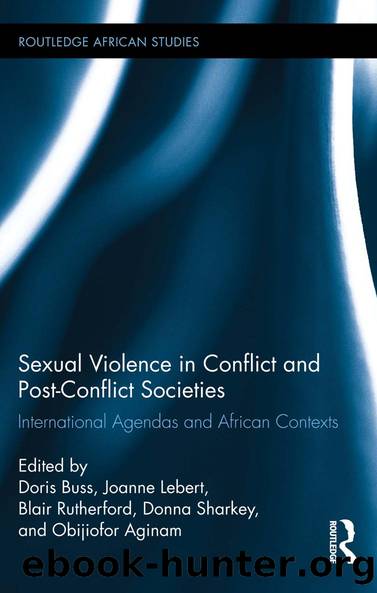Sexual Violence in Conflict and Post-Conflict Societies by unknow

Author:unknow
Language: eng
Format: epub
Tags: Nonfiction, Social & Cultural Studies, Social Science, Gender Studies, Women's Studies
ISBN: 9781317679967
Publisher: Taylor and Francis
Published: 2014-07-17T04:00:00+00:00
10 The Representation of Rape by the Special Court for Sierra Leone
Valerie Oosterveld
The United Nationsâbacked Special Court for Sierra Leone has explored the prevalence of rape1 within Sierra Leoneâs decade-long armed conflict through four trials. These trials are known informally as the Armed Forces Revolutionary Council (AFRC), Revolutionary United Front (RUF), and Civil Defence Forces (CDF) cases, as well as the case of the former president of Liberia, Charles Taylor.2 The pictures of conflict-related rape painted by each case are different. In the AFRC judgments, the focus is on the rape of women and girls within AFRC-held territory. Somewhat in contrast, the RUF judgments examine the rape of women, girls, men, and boys and place this rape within a broader context: that of the war crime of committing acts of terrorism. Combining these approaches, the Taylor trial judgmentâlike that of the AFRCâfocuses on rape of women and girls, albeit throughout territory held by the AFRC, the RUF, and affiliated fighting forces. And, like the RUF case, the Taylor judgment recognizes the crucial role played by rape in terrorizing civilians into submission to rebel forces. Again in contrast to the AFRC, RUF, and Taylor cases, the CDF case excludes discussion of rape, unfortunately erasing evidence of that crime in CDF-held territory to the detriment of victim-survivors. These varying approaches serve to both illuminate and hide the deeply ingrained role of sexual violence during Sierra Leoneâs brutal war.
The Special Court for Sierra Leone was created in 2002 as a result of an agreement between the United Nations and the government of Sierra Leone to prosecute those bearing the greatest responsibility for war crimes and crimes against humanity committed during Sierra Leoneâs armed conflict in the 1990s.3 Of the thirteen individuals accused by the prosecutor of serious crimes, ten were charged with the crimes against humanity of rape and sexual slavery and the related war crime of outrages upon personal dignity.4 This prosecutorial attention mirrored non-governmental reports of widespread, vicious sexual and gender-based violence committed during the conflict (Human Rights Watch 2003, 25â50; Physicians for Human Rights 2002, 2â4). However, the Special Courtâs jurisprudential outcomes only partially reflect this original focus on rape.
This chapter begins with an examination of the AFRC judgments, which helpfully identify how rape directed at women and girls was institutionalized by the AFRC, as well as how rape was intimately connected to other forms of AFRC violence. The AFRC judgments fail, however, to address rape directed against male civilians. This chapter then turns to an exploration of the CDF judgments. Certain evidence of rape was improperly excluded from the CDF trial and therefore from the trial judgment, marking a low point for the Special Court for Sierra Leone. The result of the exclusion of rape evidence could not be effectively âundoneâ by the Appeals Chamber, leaving a legacy of silence on rape committed within areas under CDF control. The RUF and Taylor judgments mark a high point for the Special Court in terms of the nuance in its analysis of rape.
Download
This site does not store any files on its server. We only index and link to content provided by other sites. Please contact the content providers to delete copyright contents if any and email us, we'll remove relevant links or contents immediately.
Tor and the Dark Net · Remain Anonymous Online and Evade NSA Spying (Tor, Dark Net, Anonymous Online, NSA Spying) by Smith James(206)
The Love Conspiracy: An Age-Gap Lesbian Romance by Arias J.J(169)
Carl Schmitt Between Technological Rationality and Theology by Hugo E. Herrera;(158)
If We Burn by Vincent Bevins(151)
Women before the court by Lindsay R. Moore(121)
Witches, Wife Beaters, and Whores by Elaine Forman Crane(106)
Covering Muslims by Erik Bleich;A. Maurits van der Veen;(106)
Defensive Nationalism by B. S. Rabinowitz;(105)
The Crimes of Womanhood by A. Cheree Carlson(103)
The Will to Punish by Fassin Didier;Kutz Christopher;(101)
Sexual Violence in Conflict and Post-Conflict Societies by unknow(99)
Defining Girlhood in India by Ashwini Tambe(99)
To Raise and Discipline an Army by Joshua Kastenberg(98)
Critique of the Legal Order by Richard Quinney Randall G. Shelden(96)
Police Matters by Radha Kumar(92)
International Humanitarian Law and Justice by Mats Deland Mark Klamberg Pål Wrange(91)
A New Daddy by orphan_account(91)
Advisory Boards in Medium-Sized Companies by Daniel Graewe(87)
History and Power in the Study of Law by June Starr Jane F. Collier(86)
